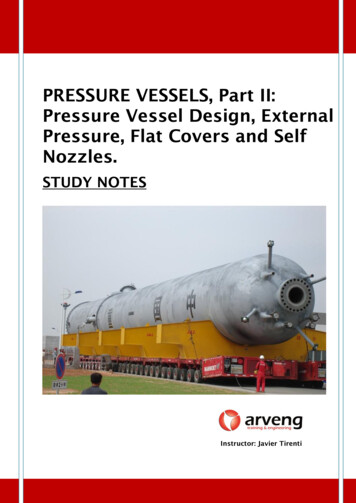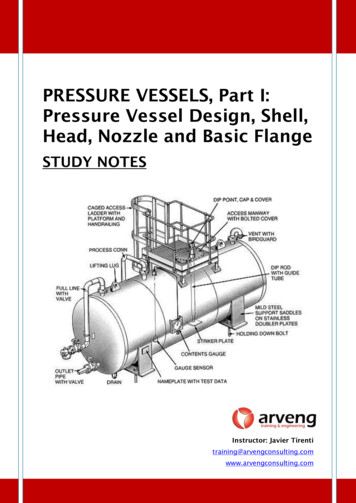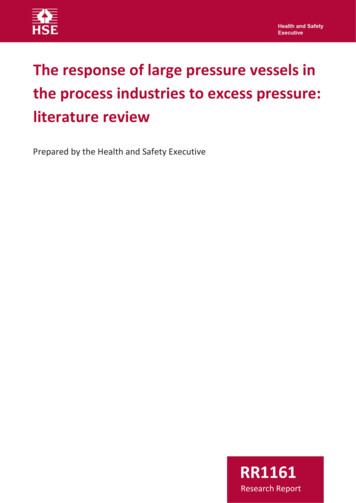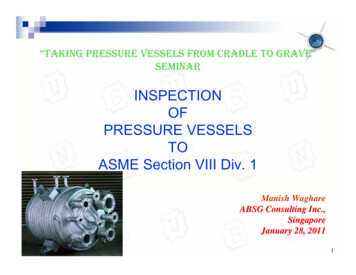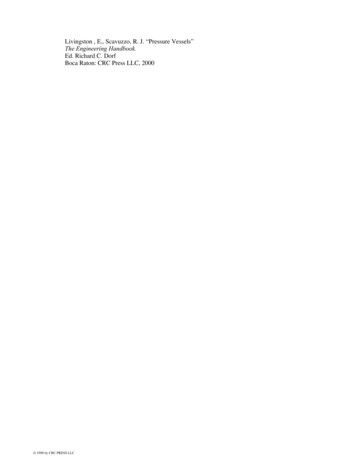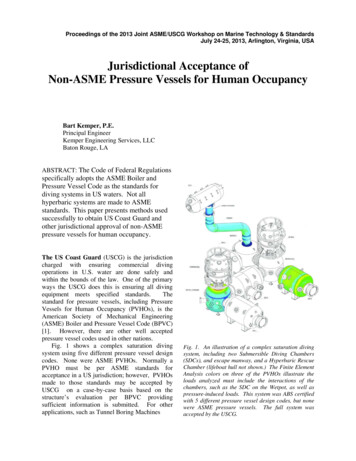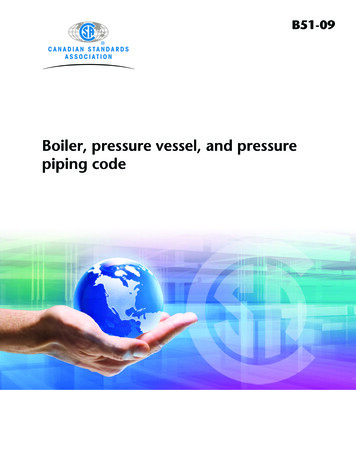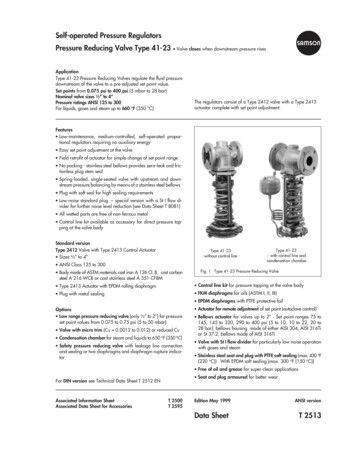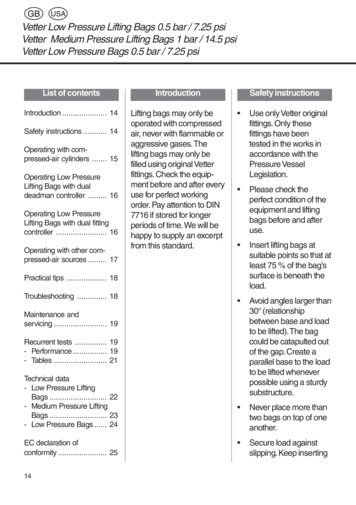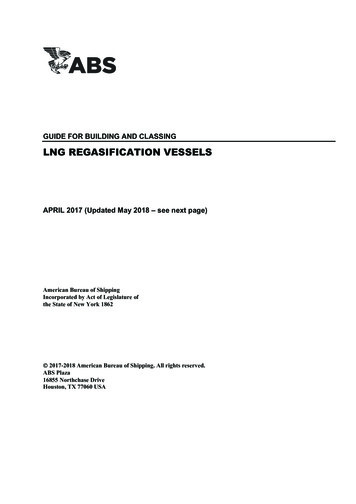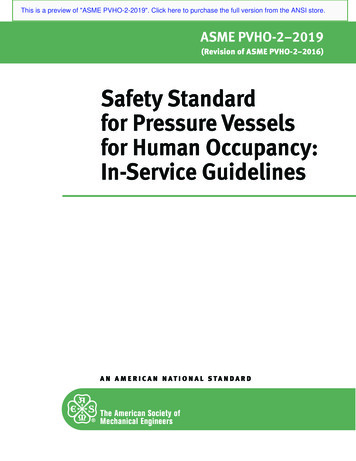
Transcription
This is a preview of "ASME PVHO-2-2019". Click here to purchase the full version from the ANSI store.ASME PVHO-2–2019(Revision of ASME PVHO-2–2016)Safety Standardfor Pressure Vesselsfor Human Occupancy:In-Service GuidelinesA N A M E R I C A N N AT I O N A L STA N DA R D
This is a preview of "ASME PVHO-2-2019". Click here to purchase the full version from the ANSI store.ASME PVHO-2–2019(Revision of ASME PVHO-2–2016)Safety Standardfor Pressure Vesselsfor Human Occupancy:In-Service GuidelinesAN AMERICAN NATIONAL STANDARDx
This is a preview of "ASME PVHO-2-2019". Click here to purchase the full version from the ANSI store.Date of Issuance: January 24, 2020The next edition of this Standard is scheduled for publication in 2022.ASME issues written replies to inquiries concerning interpretations of technical aspects of this Standard. Periodically certainactions of the ASME PVHO Committee may be published as Cases. Cases and interpretations are published on the ASME websiteunder the Committee Pages at http://cstools.asme.org/ as they are issued.Errata to codes and standards may be posted on the ASME website under the Committee Pages to provide corrections toincorrectly published items, or to correct typographical or grammatical errors in codes and standards. Such errata shall be usedon the date posted.The Committee Pages can be found at http://cstools.asme.org/. There is an option available to automatically receive an e-mailnotification when errata are posted to a particular code or standard. This option can be found on the appropriate CommitteePage after selecting “Errata” in the “Publication Information” section.ASME is the registered trademark of The American Society of Mechanical Engineers.This code or standard was developed under procedures accredited as meeting the criteria for American National Standards. The StandardsCommittee that approved the code or standard was balanced to assure that individuals from competent and concerned interests have had anopportunity to participate. The proposed code or standard was made available for public review and comment that provides an opportunityfor additional public input from industry, academia, regulatory agencies, and the public-at-large.ASME does not “approve,” “rate,” or “endorse” any item, construction, proprietary device, or activity.ASME does not take any position with respect to the validity of any patent rights asserted in connection with any items mentioned in thisdocument, and does not undertake to insure anyone utilizing a standard against liability for infringement of any applicable letters patent, norassume any such liability. Users of a code or standard are expressly advised that determination of the validity of any such patent rights, and therisk of infringement of such rights, is entirely their own responsibility.Participation by federal agency representative(s) or person(s) affiliated with industry is not to be interpreted as government or industryendorsement of this code or standard.ASME accepts responsibility for only those interpretations of this document issued in accordance with the established ASME proceduresand policies, which precludes the issuance of interpretations by individuals.No part of this document may be reproduced in any form,in an electronic retrieval system or otherwise,without the prior written permission of the publisher.The American Society of Mechanical EngineersTwo Park Avenue, New York, NY 10016-5990Copyright 2020 byTHE AMERICAN SOCIETY OF MECHANICAL ENGINEERSAll rights reservedPrinted in U.S.A.
This is a preview of "ASME PVHO-2-2019". Click here to purchase the full version from the ANSI store.CONTENTSForeword . . . . . . . . . . . . . . . . . . . . . . . . . . . . . . . . . . . . . . . . . . . . . . . . . . . . . . . . . . . . . . . . . . . . . . . .vCommittee Roster . . . . . . . . . . . . . . . . . . . . . . . . . . . . . . . . . . . . . . . . . . . . . . . . . . . . . . . . . . . . . . . . . .viCorrespondence With the PVHO Committee . . . . . . . . . . . . . . . . . . . . . . . . . . . . . . . . . . . . . . . . . . . . . . .ixSummary of Changes . . . . . . . . . . . . . . . . . . . . . . . . . . . . . . . . . . . . . . . . . . . . . . . . . . . . . . . . . . . . . . .xiSection 11-11-21-31-41-51-61-7Section 22-12-22-32-42-52-62-72-8General . . . . . . . . . . . . . . . . . . . . . . . . . . . . . . . . . . . . . . . . . . . . . . . . . . . . . . . . .Introduction and Scope . . . . . . . . . . . . . . . . . . . . . . . . . . . . . . . . . . . . . . . . . . . . . .Responsibilities and Jurisdictional Considerations . . . . . . . . . . . . . . . . . . . . . . . . . . .In-Service Evaluations, Repairs, and Modification of PVHOs . . . . . . . . . . . . . . . . . . . .PVHO and PVHO Systems Documentation . . . . . . . . . . . . . . . . . . . . . . . . . . . . . . . . .Owner’s Manual . . . . . . . . . . . . . . . . . . . . . . . . . . . . . . . . . . . . . . . . . . . . . . . . . . .Maintenance Requirements . . . . . . . . . . . . . . . . . . . . . . . . . . . . . . . . . . . . . . . . . . .Checklists and Logs . . . . . . . . . . . . . . . . . . . . . . . . . . . . . . . . . . . . . . . . . . . . . . . . .Viewports . . . . . . . . . . . . . . . . . . . . . . . . . . . . . . . . . . . . . . . . . . . . . . . . . . . . . . .Responsibilities . . . . . . . . . . . . . . . . . . . . . . . . . . . . . . . . . . . . . . . . . . . . . . . . . . . .Factors Affecting Service Life . . . . . . . . . . . . . . . . . . . . . . . . . . . . . . . . . . . . . . . . . .Handling of PVHO Windows . . . . . . . . . . . . . . . . . . . . . . . . . . . . . . . . . . . . . . . . . . .Operational and Maintenance Inspections of PVHO Viewports . . . . . . . . . . . . . . . . . .Categories of Damage . . . . . . . . . . . . . . . . . . . . . . . . . . . . . . . . . . . . . . . . . . . . . . .Repair of Damaged PVHO Windows . . . . . . . . . . . . . . . . . . . . . . . . . . . . . . . . . . . . .Mechanical Property Testing . . . . . . . . . . . . . . . . . . . . . . . . . . . . . . . . . . . . . . . . . .Testing Requirements for Increasing the 40,000-hr Design Life . . . . . . . . . . . . . . . . .1111223355567991113Mandatory AppendicesIDefinitions . . . . . . . . . . . . . . . . . . . . . . . . . . . . . . . . . . . . . . . . . . . . . . . . . . . . . . .IIReference Standards and Specifications . . . . . . . . . . . . . . . . . . . . . . . . . . . . . . . . . . .IIIQuality Assurance Program for Repair of Severely Damaged Windows . . . . . . . . . . . .IVAdditional Window Repair Requirements and Forms . . . . . . . . . . . . . . . . . . . . . . . . .VPartial List of Harmful Substances and Acceptable Products . . . . . . . . . . . . . . . . . . . .VIMechanical Testing Computations and Forms . . . . . . . . . . . . . . . . . . . . . . . . . . . . . .242728313840Nonmandatory AppendicesAChecklists and Logs for PVHO Operation . . . . . . . . . . . . . . . . . . . . . . . . . . . . . . . . . . . .BOperation of Submersible Craft . . . . . . . . . . . . . . . . . . . . . . . . . . . . . . . . . . . . . . . . . .4445Tables2-4.1-12-4.1.1-12-4.1.1-2141517Periodic Inspection Requirements . . . . . . . . . . . . . . . . . . . . . . . . . . . . . . . . . . . . . . . .Limits for Blemishes or Flaws on Standard Window Geometry Surfaces . . . . . . . . . . . . .Limits for Blemishes or Flaws on All Other Standard Window Geometry Surfaces . . . . . .iii
This is a preview of "ASME PVHO-2-2019". Click here to purchase the full version from the ANSI -1VI-2Limits on Chipping of Sharp Edges on Standard Window Geometries . . . . . . . . . . . . . . .Maximum Intervals for Maintenance Viewport Inspection . . . . . . . . . . . . . . . . . . . . . . .Maximum Intervals for Refurbishment . . . . . . . . . . . . . . . . . . . . . . . . . . . . . . . . . . . . .Specified Values of Physical Properties for Spot Casting Repairs (To Be Verified by Testing ofSpecimens Taken From Test Castings of the Same Slurry Batch Used in Repair) . . . . .Annealing Schedule for Acrylic Windows Part A: Minimum Heating Times for ElevatedTemperature Annealing of Acrylic . . . . . . . . . . . . . . . . . . . . . . . . . . . . . . . . . . . . . .Annealing Schedule for Acrylic Windows Part B: Maximum Cooling Rates for Acrylic Subjectedto Elevated Annealing Temperatures . . . . . . . . . . . . . . . . . . . . . . . . . . . . . . . . . . . .Example Evaluation — Mandatory Appendix VI . . . . . . . . . . . . . . . . . . . . . . . . . . . . . . .Viewport Inspection . . . . . . . . . . . . . . . . . . . . . . . . . . . . . . . . . . . . . . . . . . . . . . . . . .Acrylic Window Repair Certification for Severely Damaged Windows . . . . . . . . . . . . . . .Acrylic Window Repair Certification for Slightly Damaged Windows Repaired by the User (orthe User’s Authorized Agent) . . . . . . . . . . . . . . . . . . . . . . . . . . . . . . . . . . . . . . . . . .Pressure Testing Report for Increasing Window Service Life Beyond the 40,000-hr Design LifeMaterial Testing Certification for Repair by Spot Casting . . . . . . . . . . . . . . . . . . . . . . . .Annealing Process Certification . . . . . . . . . . . . . . . . . . . . . . . . . . . . . . . . . . . . . . . . . .Pressure Testing Certification . . . . . . . . . . . . . . . . . . . . . . . . . . . . . . . . . . . . . . . . . . . .Material Testing Results for Continued Service . . . . . . . . . . . . . . . . . . . . . . . . . . . . . . .Material Testing Evaluation for Continued Service . . . . . . . . . . . . . . . . . . . . . . . . . . . . .iv18181832333441192022233536374243
This is a preview of "ASME PVHO-2-2019". Click here to purchase the full version from the ANSI store.FOREWORDIn 1998 a PVHO Task Group was formed to investigate the need for In-Service Rules and Guidelines for Pressure Vesselsfor Human Occupancy. Simultaneously, a Sub Task Group was formed to investigate the issue of acrylic window design lifeversus service life. The design life is based on the PVHO window being exposed to the maximum allowable workingpressure (MAWP), at the maximum rated temperature, for the maximum number of (design) cycles, in an outdoorweathering environment. The majority of PVHOs are not operated to such extremes, and service life may indeedbe longer than design life. Conversely, if a window is not properly cared for (i.e., becomes exposed, either operationallyor nonoperationally, to other detrimental factors that are not, and cannot be, factored into the design life), then the actualservice life could be much shorter than the design life. Thus, the recommendation was made that design life and service lifebe addressed as two different subjects. In 1999 the In-Service Task Group became a PVHO subcommittee, with the mostimmediate task being the establishment of in-service criteria for PVHO windows and viewports.This Standard provides the necessary in-service criteria to supplement Section 2, Viewports, of ASME PVHO-1, whichapplies to new construction only. By comparison, this Standard applies to all ASME PVHO-1 acrylic windows, regardless oftheir date of manufacture. This Standard consists of both technical criteria and guidelines. They are intended to provideguidance to the user and/or the jurisdictional authority in regard to the establishment of potential service life, and thenecessary care, inspection, and repair during that service life—depending on the actual service conditions to which thePVHO and windows have been, or will be, exposed.Finally, this Standard was prepared as a “stand-alone” document. All forms additional to those normally supplied withthe window in accordance with ASME PVHO-1, which may be necessary throughout the service life of the window, areprovided herein. Similarly, all necessary ASME PVHO-1 technical data applicable to service and repair (if required) arealso provided in this Standard.The 2019 edition of ASME PVHO-2 further develops and clarifies the in-service guidelines for PVHOs. The requirementsfor in-service pressure testing gauge calibration have been updated. Nonmandatory Appendix A, covering checklists andlogs for PVHO operation, has been deleted, and the text under this appendix has been integrated into the general requirements of Section 1. New testing criteria for increasing the 40,000-hr design life of acrylic windows have beenincorporated under Section 2. Additionally, new forms have been added, and some of the existing forms have beenupdated.Sections on the following topics are in development are in development and may be included in future editions: qualityassurance for PVHO manufacturers, piping systems, medical hyperbaric systems, diving systems, and submersibles.Previous editions of this Standard were issued in 2003, 2012, and 2016. The 2019 edition of this Standard wasapproved by the American National Standards Institute as an American National Standard on December 4, 2019.v
This is a preview of "ASME PVHO-2-2019". Click here to purchase the full version from the ANSI store.ASME PRESSURE VESSELS FORHUMAN OCCUPANCY COMMITTEE(The following is the roster of the Committee as of February 1, 2019.)STANDARDS COMMITTEE OFFICERSG. Wolfe, ChairJ. Witney, Vice ChairE. Lawson, SecretarySTANDARDS COMMITTEE PERSONNELJ. E. Crouch, Southwest Research InstituteB. Faircloth, FMS Engineering, LLCM. A. Frey, Naval Sea Systems CommandT. R. Galloway, Naval Sea Systems CommandB. Kemper, Kemper Engineering Services, LLCW. Kohnen, Hydrospace Group, Inc.D. Lawrence, U.S. Coast GuardE. Lawson, The American Society of Mechanical EngineersS. Reimers, Reimers Systems, Inc.G. Richards, Blanson, Ltd.T. C. Schmidt, Lockheed MartinK. A. Smith, U.S. Coast GuardR. C. Smith, Naval Facilities Engineering Command, Ocean FacilitiesProgramJ. Stromer, Triton SubmarinesD. Talati, Sechrist Industries, Inc.R. Thomas, American Bureau of Shi
Similarly, all necessary ASME PVHO-1 technical data applicable to service and repair (if required) are also provided in this Standard. The 2019 edition of ASME PVHO-2 further develops and clarifies the in-service guidelines for PVHOs. The requirements for in-service pressure testing gauge calibration have been updated. Nonmandatory Appendix A, covering checklists and logs for PVHO operation .
